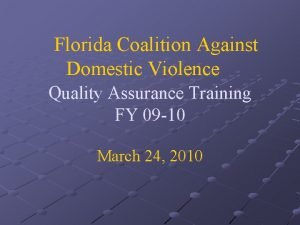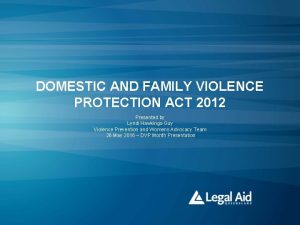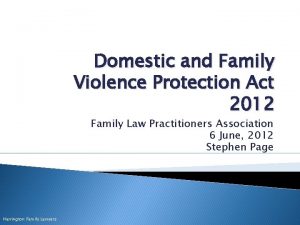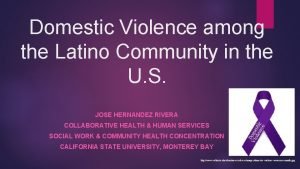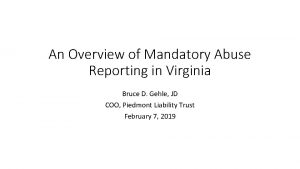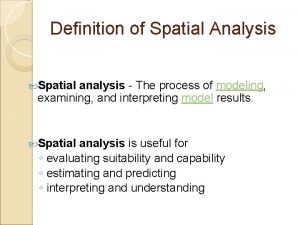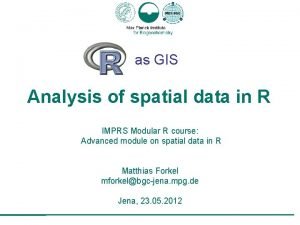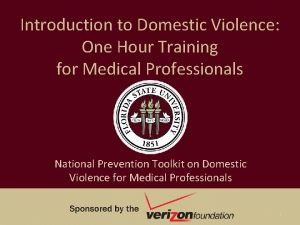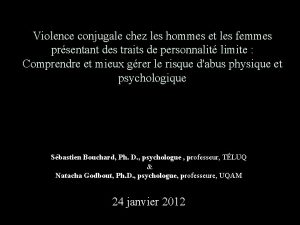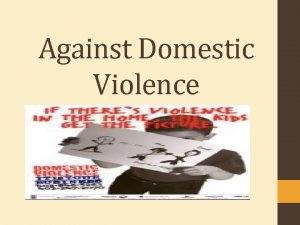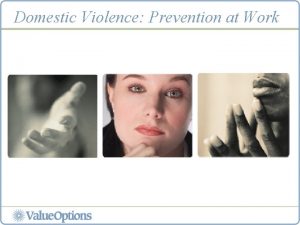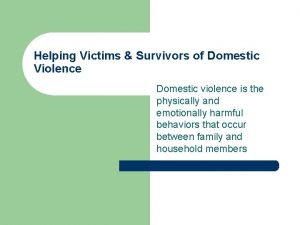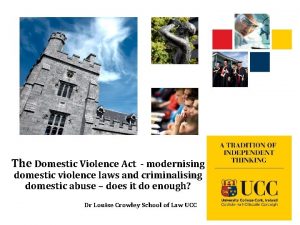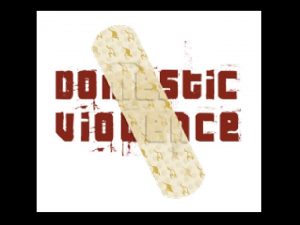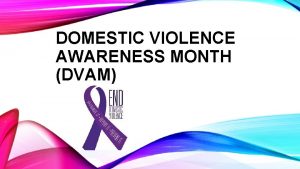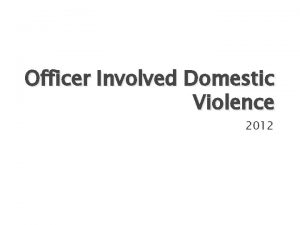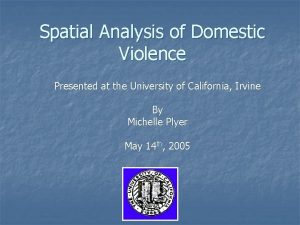A SPATIAL ANALYSIS OF DOMESTIC VIOLENCE A STUDY































- Slides: 31

A SPATIAL ANALYSIS OF DOMESTIC VIOLENCE: A STUDY OF SANTA ANA Anet Badali Faculty Mentor James W. Meeker, Ph. D, J. D Criminology, Law and Society University of California, Irvine

Domestic Violence in Context § Sociologist C. Wright Mills Consider marriage. Inside a marriage a man and a woman may experience personal troubles, but when the divorce rate during the first four years of marriage is 250 out of every 1, 000 attempts, this is an indication of a structural issue having to do with the institutions of marriage and the family and other institutions that bear upon them. . . In the United States, four women die every day due to domestic violence. FBI has reported approximately 1400 a year § (National Organization for Women, 2006). 572, 000 reports of assaults are officially reported each year, but estimates indicate two to four million cases (National § Organization for Women, 2006).

Overview: Domestic Violence in Santa Ana, California § § § OBJECTIVES: To identify sociodemographic variables that correlate to increased rates of domestic abuse. To identify potential predictive models of domestic violence. Multi-agency perspective on a social problem. Map represents an aerial photograph of the city of Santa Ana with an outline of the streets.

Main Objectives § To allow local agencies to evaluate the type of impact they have had within the community. § § § Ex: Are residents utilizing resources? To influence local agencies to engage in a collaborative effort to curb domestic violence. To begin allocating resources more effectively and to the right population.

Data § § Addresses of residents who have identified domestic abuse across 3 local agencies from 2003 -2006. Santa Ana Police Department § Legal Aid Society of Orange County § Survey of helpline call-in clients who self-identified as domestic abuse victims within the past year. Orange County Courts § Calls for service where officers were dispatched for domestic abuse incidents. Addresses of residents who have obtained Temporary Restraining Orders (TROs) in domestic situations. Demographic information obtained from U. S. Census Bureau website.

Data Continued. . Legal Aid 2003: 346 self-identified 2004: 279 self-identified 2005: 279 self- identified 2006: 142 self-identified Court 2003: 295 TROs 2004: 628 TROs 2005: 554 TROs 2006: 492 TROs Police 2003: 5456 incidents 2004: 5278 incidents 2005: 5130 incidents 2006: 4943 incidents

Research Design Geographic Information System (GIS) Spatial Mapping and 3 D Analysis Plot out addresses and create “Hot Spots” SPSS Statistical Analysis Correlation and Regression §Domestic violence was operationalized using PD data -Incidents of domestic violence §Help-Seeking was operationalized using Court data - Obtaining a TRO shows an effort to help oneself

Poverty Levels in Santa Ana

Domestic Violence Incidents in 2006

PD 2003 Kernal Density/Hot Spots

PD 2004 Kernal Density/Hot Spots

PD 2005 Kernal Density/Hot Spots

PD 2006 Kernal Density/Hot Spots

TRO 2003 Kernal Density/ Hot Spots

TRO 2004 Kernal Density/Hot Spots

TRO 2005 Kernal Density/Hot Spots

TRO 2006 Kernal Density/Hot Spots

Analysis: Correlations § Hypothesized following variables would correlate to help-seeking behavior: Ø Poverty Ø Race and Ethnicity Ø Married Households with Children Ø Foreign Born Status Ø Average Family Size

Findings Positive correlation exists between: Poverty Average Family Size Married Households with Children Choropleth map computed using POVSTATTOT which is the sum of residents living within 200% of the poverty line. The elevation levels represent TROs obtained in each block group from 2003 -2006.

Findings Continued. . Regression Analysis - best predictors of help-seeking behavior are: Poverty § 2006 PD Data § Married Households with Children § Explain about 46% of the variance § Multiple Regression test: § Poverty § 2006 PD Data Indications: § Found that 2006 PD data better predictor of 2006 Court data than previous court data. § Collaborative efforts in targeting areas for potential outreach may prove to be effective. § To predict help-seeking behavior, should be studying what is happening here and now.

Patterns of Help-Seeking Behavior § § § Identified addresses with 20 (+) hits across agencies. Used unit numbers to track patterns and trends. 74% of households contacted PD only. 1% reached out to Courts only. Of the remaining 145 (25%) households about 20% reached out to Courts first then had contact with Police. 49% had contact with Police then reached out to Courts. Total number of addresses 92 Total units numbers within 92 addresses 588 Police Department Only 437 Court Only 6 Court to Police Department 30 Police Department to Court 74

92 Address Locations


Areas of Interest





Future Research § § § Continue monitoring help-seeking behavior in order to effectively allocate resources. Continue data collection to build a strong and accurate model. Extend the project to surrounding cities in Orange County. Are the findings the same?

Acknowledgements Professor James W. Meeker Professor Valerie Jenness Professor George E. Tita Professor John Hipp Professor Joe Devoy Elvis Tran Santa Ana Police Department Chief Walters and Commander Gominsky Legal Aid Society of Orange County Bob Cohen Orange County Courts Sandy Hilger Director, Planning and Research Unit

If you would like more information… Anet Badali ABadali@uci. edu
 Florida coalition against domestic violence
Florida coalition against domestic violence Domestic and family violence protection act 2012
Domestic and family violence protection act 2012 Three r's for stopping domestic violence
Three r's for stopping domestic violence Domestic violence kink
Domestic violence kink Domestic and family violence protection act 2012
Domestic and family violence protection act 2012 Routine, universal screening for domestic violence means: *
Routine, universal screening for domestic violence means: * Domestic violence in the hispanic community
Domestic violence in the hispanic community Virginia mandatory reporting law domestic violence
Virginia mandatory reporting law domestic violence Oflinemaps
Oflinemaps Spatial analysis questions
Spatial analysis questions Raster overlay
Raster overlay Spatial design network analysis
Spatial design network analysis Centre for advanced spatial analysis
Centre for advanced spatial analysis Applied spatial data analysis with r
Applied spatial data analysis with r Indicators of potential workplace violence
Indicators of potential workplace violence Ignorance human act
Ignorance human act Violent one hour
Violent one hour Thesis statement about gun control
Thesis statement about gun control Chapter 9 lesson 3 understanding violence
Chapter 9 lesson 3 understanding violence Different types of violence
Different types of violence Gandhi king and mandela what made non-violence work dbq
Gandhi king and mandela what made non-violence work dbq Chapter 9 lesson 2 resolving conflicts
Chapter 9 lesson 2 resolving conflicts Chapter 27 anger aggression and violence
Chapter 27 anger aggression and violence Expressive violence definition
Expressive violence definition Chapter 10 section 2 protest resistance and violence
Chapter 10 section 2 protest resistance and violence Indicators of potential workplace violence
Indicators of potential workplace violence Borderline violence conjugale
Borderline violence conjugale Galtung’s conflict triangle
Galtung’s conflict triangle Pyramid of gender based violence
Pyramid of gender based violence Family violence intervention program atlanta
Family violence intervention program atlanta Chapter 9 resolving conflicts and preventing violence
Chapter 9 resolving conflicts and preventing violence Chapter 10 section 2 protest resistance and violence
Chapter 10 section 2 protest resistance and violence
